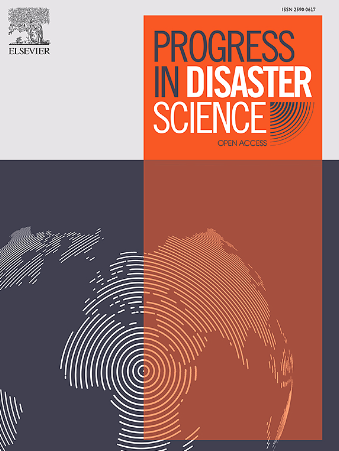Flood mapping, damage assessment, and susceptibility zonation in northeastern Bangladesh in 2022 using geospatial datasets
IF 3.8
Q3 ENVIRONMENTAL SCIENCES
引用次数: 0
Abstract
This study assesses flood inundation, impacts, and susceptibility zones in northeastern Bangladesh during the 2022 flood. The region is highly vulnerable to recurrent flooding Due to its geographic position and climate change impacts. The Sentinel-1 SAR data on the Google Earth Engine (GEE) platform was used to generate flooded areas using a simple change detection technique with thresholding. This analysis was further supported by incorporating cropland, population, national highway, and DEM datasets for a comprehensive damage assessment. Findings show that 55.76 % (10,993.09 km2) of the area was inundated, impacting 10.69 million people and causing severe displacement and health hazards. Sylhet, Kishoreganj, and Brahmanbaria districts were the most affected, with 2.73 million impacted in Sylhet alone. Additionally, 67.87 % of agricultural land was flooded, particularly in Sunamganj, and 43.38 % of national highways (535.08 km2) were damaged. A flood susceptibility zonation map identified high-susceptibility areas like central Sunamganj and parts of Kishoreganj to assist authorities in resource allocation and mitigation. The flood extent model achieved strong predictive accuracy (AUC: 0.97 % RF, 0.96 % LR, and 0.94 % DT), providing crucial insights for regional flood management and guiding communities with limited modeling capacities.
利用地理空间数据集绘制2022年孟加拉国东北部洪水地图、灾害评估和易感性分区
本研究评估了2022年洪水期间孟加拉国东北部的洪水淹没、影响和易感区。由于地理位置和气候变化的影响,该地区极易受到经常性洪水的影响。利用谷歌地球引擎(GEE)平台上的Sentinel-1 SAR数据,采用简单的阈值变化检测技术生成洪水区域。结合农田、人口、国家公路和DEM数据集进行综合损害评估,进一步支持了这一分析。结果表明,55.76% (10993.09 km2)的区域被淹没,影响了1069万人,造成了严重的流离失所和健康危害。Sylhet、Kishoreganj和Brahmanbaria地区受影响最严重,仅Sylhet地区就有273万人受到影响。此外,67.87%的农业用地被淹没,特别是在水南甘吉,43.38%的国道(535.08平方公里)被破坏。洪水易感性分区图确定了苏南甘杰中部和基肖雷甘杰部分地区等高易感性地区,以协助当局分配资源和减轻灾害。该模型具有较强的预测精度(AUC: RF = 0.97%, LR = 0.96%, DT = 0.94%),为区域洪水管理提供了重要见解,并为建模能力有限的社区提供了指导。
本文章由计算机程序翻译,如有差异,请以英文原文为准。
求助全文
约1分钟内获得全文
求助全文
来源期刊

Progress in Disaster Science
Social Sciences-Safety Research
CiteScore
14.60
自引率
3.20%
发文量
51
审稿时长
12 weeks
期刊介绍:
Progress in Disaster Science is a Gold Open Access journal focusing on integrating research and policy in disaster research, and publishes original research papers and invited viewpoint articles on disaster risk reduction; response; emergency management and recovery.
A key part of the Journal's Publication output will see key experts invited to assess and comment on the current trends in disaster research, as well as highlight key papers.
 求助内容:
求助内容: 应助结果提醒方式:
应助结果提醒方式:


